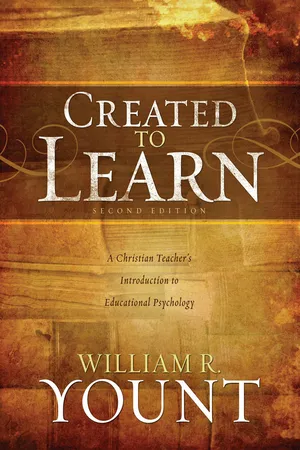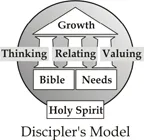![]()
UNIT 1
Educational Psychology and the Christian Teacher
Teaching is both art and science. The best teachers weave together competing elements—content and communication, justice and grace, control and nurture, challenge and support—in order to help learners grow. Teaching is art in that this weaving of elements happens spontaneously, in the heat of battle, in the very acts of engaging human learners. Teacher-artists paint colorful mental landscapes, frame questions on the spot, respond warmly to learners "in the moment," and use humor to dispel tension or drive home a point. Such an artistic weaving of elements flows out of the personality of the teacher, making the process unique for each teacher.
Teaching is science in that the best teachers employ widely accepted principles for establishing knowledge, expediting understanding, facilitating attitude change, and shaping behavior. These principles are grounded in tangible processes, discovered through scientific investigation and empirical observation. Teacher-scientists investigate the most effective ways to create positive learning environments, address learner differences, engage learners head, heart, and hand,1 explain terms and concepts clearly, question learners appropriately, and set reasonable expectations through measurable instructional objectives. Scientific fundamentals flow out of the field of educational psychology and anchor teachers in a common process.
Educational psychology presents the scientific framework for the art of teaching. The word education comes from the Latin educare, ["bring up, to rear"]2 and refers to the process of developing "the faculties and powers of a person by teaching, instruction, or schooling."3 The word psychology combines the Greek words psyche- and logos. Psyche- means "soul, life,"4 and logos means "1) Discourse, expression or 2) Science, theory, study."5 Psychology is the study or science of the soul, the person, the individual—particularly with regard to mental processes and behavior. Educational psychology, then, is the study of the individual as learner.
God created us to learn and provided the Church as the context. God reveals Himself as Creator (Gen 1–2). He created humankind in His image, male and female, (Gen 1:26–28)—created us to learn of Him. He is Teacher, enlightening us, guiding, training, and lifting us (Deut 4:1–14).6 Jesus, the express image of God in flesh, was known best as a Teacher, Master, and Rabbi as He taught how to live as citizens of His kingdom.7 The Church is primarily a reaching-teaching institution, drawing people to faith in Christ, and then growing them to full citizenship in the kingdom,8 through the power and presence of the Holy Spirit, our Teacher. Through its associated classes, schools, colleges, and seminaries, the Church expands its discipling and equipping functions to both citizens and leaders in God's kingdom.
The teaching task is both nurturing and instructive. The apostle Paul writes "[Christ] gave some to be . . . pastors [shepherds, nurturers] and teachers [trainers, instructors] for the training of the saints in the work of ministry, to build up the body of Christ, until we all reach unity in the faith and in the knowledge of God's Son, growing into a mature man" (Eph 4:11–13).
Educational psychology stands as one of the foundational disciplines of the teaching-learning process. Anyone who desires greater effectiveness as a teacher will benefit from the findings of educational psychologists. But what, you may ask, can we, as Christian teachers, learn from secular theorists? And yet we engage spiritually neutral things every day. We order our days by weather forecasts anchored in the science of meteorology. We speed our travel by trusting our lives to modern jetliners, built according to the scientific laws of aerodynamics. We manage our diets according to the latest findings on nutrition, derived from the science of biology. Many of us get our news by way of computers, cell phones, and the Internet, all produced by the science of microelectronics. None of these tools are Christian.
Moreover, we regularly seek help from nonspiritual sources. When our cars needs repair, do we seek a pastor or a mechanic? When our teeth need work, do we look for a theologian or a dentist? When our drains are clogged, should we consult a seminary professor or a plumber? When we want to know which highways to take from A to B, do we consult the Bible or a recent map? The answers are obvious.
In the same way, discoveries made by men and women who have given their lives to the study of human learning can help us as well. Why should we not study what researchers have to say, "taking every thought captive to the obedience of Christ" (2 Cor 10:5)? What have dedicated men and women discovered through scientific investigation and educational observation? How might we transfer these discoveries into a Christian context? Unit I addresses these issues by first establishing the Disciplers' Model as the Christian context for the study of learning and then analyzing the scientific approach to knowing.
Chapter 1: The Disciplers' Model
The seven elements of the Disciplers' Model provide a philosophical and theological framework for the remainder of the text. "Eternal Truth speaking to contemporary Need" are the two elements of the foundation. The three tangible systems that energize the discipling process are rational, emotional, and social. The ultimate goal of the process is maturational. The Primary Enabler of the process is the Holy Spirit.
We connect six of these biblical elements with their counterparts in educational psychology: content, individual differences, cognitive development, affective development, social development, and maturation.
Chapter 2: Knowing, Science, and the Christian Teacher
The grand scope of philosophy sets before us three Great Problems. The second of these, and the one most important to us here, is called epistemology9 and defines several distinct ways that human beings achieve knowledge of the world. Educational psychology is a scientific discipline and uses scientific means to define educational truth. How does knowledge discovered by science differ from other ways of knowing?
Chapter Two investigates seven ways we gain the knowledge we have: common sense, tradition, authority, intuition and revelation, experience, deductive reasoning, and inductive reasoning. The chapter then defines scientific knowing and describes how it functions. Finally, we compare and contrast faith and science as ways of knowing.
![]()
1
THE DISCIPLERS' MODEL
And He personally gave some to be apostles, some prophets, some evangelists, some pastors and teachers, for the training of the saints in the work of ministry, to build up the body of Christ, until we all reach unity in the faith and in the knowledge of God's Son, growing into a mature man with a stature measured by Christ's fullness. Then we will no longer be little children, tossed by the waves and blown around by every wind of teaching, by human cunning with cleverness in the techniques of deceit. But speaking the truth in love, let us grow in every way into Him who is the head—Christ. From Him the whole body, fitted and knit together by every supporting ligament, promotes the growth of the body for building up itself in love by the proper working of each individual part.
Ephesians 4:12–16
The actual well seen is ideal.
—Thomas Carlyle1
Chapter Overview
The Left Foundation Stone: The Bible
The Right Foundation Stone: The Needs of People
The Left Pillar: Helping People Think
The Right Pillar: Helping People Value
The Center Pillar: Helping People Relate
The Capstone: Helping People Grow
The Circle: Holy Spirit as Discipler
The Relationship between the Disciplers' Model and Educational Psychology
Faith in Scripture—Suspicion of Science
Chapter Concepts, Chapter Objectives, Discussion Questions Introduction
In 1971 I began teaching a Sunday school class for deaf college students attending Gallaudet College (where my wife and I worked as dormitory counselors) at Columbia Baptist Church in Falls Church, Virginia. There were no books on teaching deaf adults, and so I began to pray: "Lord, how can I teach so that these learners will grow up in You?" In response to this constant prayer, the Lord brought many experiences into the classroom sessions. In 1973 I began formal studies in educational psychology and philosophy at Southwestern Seminary. I was called as minister to the deaf at First Baptist Church, Irving, Texas, where I continued to teach deaf adults (1973–1976). In December 1976 I accepted the call to return to Columbia Baptist as their minister of education. In January 1977 the personal experiences and formal studies coalesced into what I called "The Disciplers' Model." The first publication of the Model appeared in the spring of 1977 as a series of eight articles in the church's weekly newsletter. Over the next two years, materials were added from teacher training meetings and teacher conferences. In 1979 the self-published Disciplers was produced and sold to nearly 1200 churches. In 1981 the text was revised and renamed The Disciplers' Handbook and has served as my basic text for Principles of Teaching classes at Southwestern since then.
The Model has been reinforced through nearly forty years of serving on church staffs as minister of education, teaching seminary students here and in the former Soviet Union, and leading church-based teacher conferences across the nation. I have found the Model to be an excellent bridge between secular psychological theories and a biblical worldview. We begin with the foundation: the left foundation stone is the Bible, God's eternal Word.
The Left Foundation Stone: The Bible
The left foundation stone of the Model represents the Bible, the Word of God. Unless our teaching produces a clearer understanding of the Bible, with its call to personal commitment to Christ and His Church, all our teaching efforts produce little more than "wood, hay, or straw" (1 Cor 3:12). For education to be rightly called "Christian," it must be built upon the sure foundation of God's Word.
How Does the Bible Define Itself?
Theories of inspiration thrive, and conflicting interpretations abound, but God's Word still speaks across the ages to people today. How does Scripture define itself?
Divinely Inspired. Scripture emphasizes that the Lord, not man, speaks through Scri...












